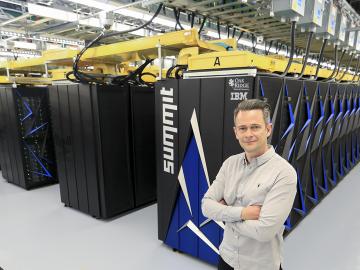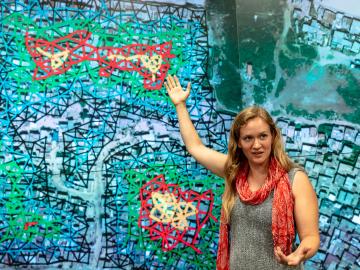Filter News
Area of Research
News Type
News Topics
- 3-D Printing/Advanced Manufacturing (5)
- Advanced Reactors (1)
- Artificial Intelligence (4)
- Big Data (2)
- Bioenergy (4)
- Biomedical (2)
- Biotechnology (1)
- Clean Water (2)
- Computer Science (12)
- Energy Storage (3)
- Environment (9)
- Exascale Computing (1)
- Grid (1)
- Machine Learning (1)
- Materials Science (4)
- Mercury (1)
- Microscopy (1)
- Nanotechnology (2)
- Neutron Science (4)
- Nuclear Energy (7)
- Physics (2)
- Polymers (1)
- Quantum Science (2)
- Space Exploration (1)
- Summit (4)
- Sustainable Energy (1)
- Transportation (3)
Media Contacts

Two of the researchers who share the Nobel Prize in Chemistry announced Wednesday—John B. Goodenough of the University of Texas at Austin and M. Stanley Whittingham of Binghamton University in New York—have research ties to ORNL.

The type of vehicle that will carry people to the Red Planet is shaping up to be “like a two-story house you’re trying to land on another planet.

At the nexus of theory and computation, physicist Gaute Hagen of the Department of Energy’s Oak Ridge National Laboratory runs advanced models on powerful supercomputers to explore how protons and neutrons interact to “build” an atomic nucleus from

Christa Brelsford, a Liane B. Russell Fellow at the Department of Energy’s Oak Ridge National Laboratory, decided as a teenager growing up in rural Alaska to use her empirical mind and math and science skills to do good in the world.

Scientists at the US Department of Energy’s Oak Ridge National Laboratory have demonstrated a method to insert genes into a variety of microorganisms that previously would not accept foreign DNA, with the goal of creating custom microbes to break down plants for bioenergy.

A modern, healthy transportation system is vital to the nation’s economic security and the American standard of living. The U.S. Department of Energy’s Oak Ridge National Laboratory (ORNL) is engaged in a broad portfolio of scientific research for improved mobility

As a computational hydrologist at Oak Ridge National Laboratory, Ethan Coon combines his talent for math with his love of coding to solve big science questions about water quality, water availability for energy production, climate change, and the

Ask Tyler Gerczak to find a negative in working at the Department of Energy’s Oak Ridge National Laboratory, and his only complaint is the summer weather. It is not as forgiving as the summers in Pulaski, Wisconsin, his hometown.

More than 6,000 veterans died by suicide in 2016, and from 2005 to 2016, the rate of veteran suicides in the United States increased by more than 25 percent.

Artificial intelligence (AI) techniques have the potential to support medical decision-making, from diagnosing diseases to prescribing treatments. But to prioritize patient safety, researchers and practitioners must first ensure such methods are accurate.




